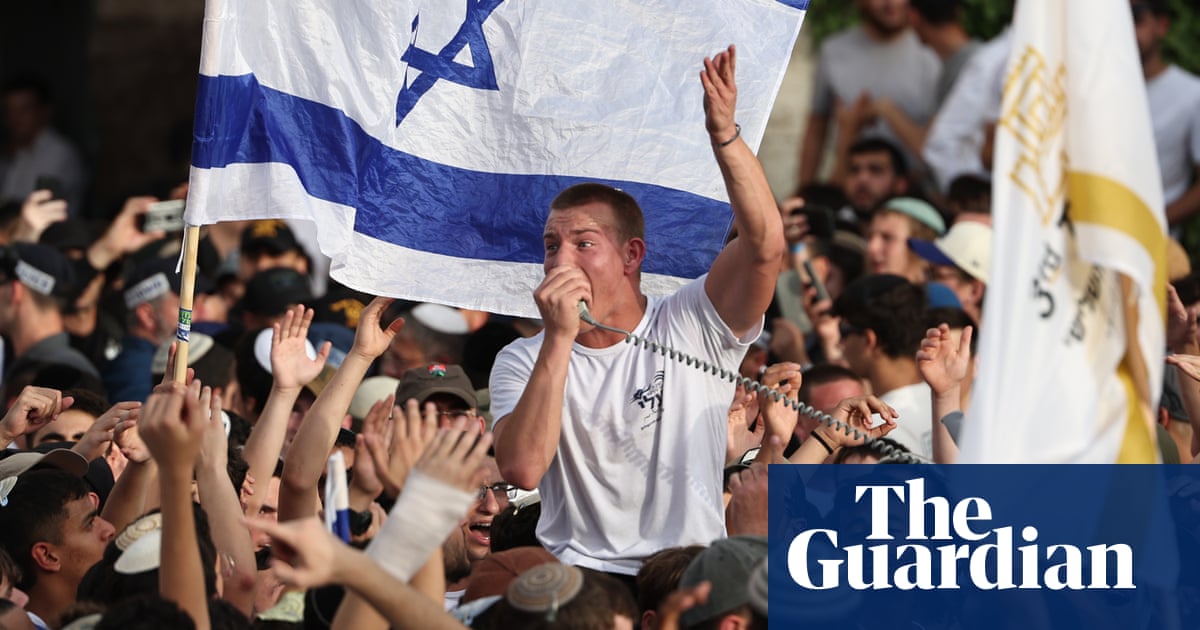Thousands of Israelis have joined a state-funded march through the Muslim quarter of the Old City in Jerusalem, where large groups chanted racist slogans including “Gaza is ours”, “death to the Arabs” and “may their villages burn”.
The annual march, paid for and promoted by the Jerusalem city government, celebrates Israel’s capture and occupation of East Jerusalem and its holy sites in the war of 1967. The Israeli takeover is not recognised internationally.
The Jerusalem municipality advertises the event, known as the flag march, as a “festive procession”, part of a broader programme of events celebrating the “liberation” of the city.
The march has been marred by racism and attacks on Palestinians for years, and is preceded by a campaign of violence in the Old City that in effect shuts down Palestinian majority areas, particularly in the Muslim Quarter.
From before midday on Monday small groups of young Israeli men attacked and harassed shopkeepers and passersby inside the city, spitting at women in hijabs, stealing from cafes, ransacking a bookshop and entering at least one home by force.
“Shut now, or I can’t protect you,” a police officer told cafe owner Raymond Himo, when he protested about teenagers in religious Zionist dress stealing drinks. On Monday, shops had mostly closed by 1pm, hours earlier than in previous years, with residents barricaded in their homes.
Aviv Tatarsky, a researcher with the Ir Amim non-profit that works for an equitable Jerusalem, said: “It deprives people of their economic livelihood, makes them feel unsafe in their surroundings. Symbolically it sends a message: ‘You don’t belong here, we are the ones who own this place.’”
From midday, groups of Jewish men inside the city shouted racist chants including “may their villages burn”, “Mohammed is dead” and “death to Arabs”.
Those slogans were picked by larger groups of mostly men that began arriving in the late afternoon. Women approached the Western Wall on a separate march, which is largely divided by gender for religious reasons.
One large group arriving at the Damascus Gate chanted “Gaza is ours”, and carried a large banner reading “Jerusalem 1967,Gaza2025”, in effect threatening full military annexation of the strip to echo the capture of East Jerusalem.
Another banner read a “without a Nakba there is no victory”, referring to the forcible expulsion of about 700,000 Palestinians when the state of Israel was created in 1948.
The procession is coordinated by “Am K’Lavi”, a non-profit whose only activity is organising the flag day march. It is chaired by Baruch Kahane, the son of Meir Kahane, a Jewish supremacist Rabbi who founded the Kach party. Banned as a political party in Israel in the 1980s under anti-terror legislation, it is now a far-right movement.
Some marchers wore T-shirts with the party’s symbol of a clenched fist in a star of David. Others wore shirts with the names of their high schools, which had organised group outings to the march.
Despite the history of violence at the march there was a relatively light police presence inside the Old City, and they did little to protect many of the Palestinians targeted with violence.
Activists from the group Standing Together, who stood as human shields in front of attackers protected only by purple gilets identifying them as members were often the only barrier preventing the violence escalating.
The far-right national security minister Itamar Ben-Gvir was among the crowds arriving at the Old City around sunset. He had earlier made an inflammatory trip to pray at al-Aqsa mosque in its compound, where officially Israel does not permit Jewish believers to carry out religious rituals.
The prime minister,Benjamin Netanyahu, hosted a cabinet meeting in Silwan, in occupied East Jerusalem. He ignored warnings from the Shin Bet security service that it would be an inflammatory move, Israeli media reported.
The flag march is already seen as a violent and deeply provocative expression of Jewish control of Jerusalem, which has in the past triggered broader conflict. Violence at the same eventhelped spark the 11-day war between Israel and Hamas in 2021.
Danny Seidemann, an Israeli attorney specialising in the geopolitics of Jerusalem, described Netanyahu’s cabinet meeting as political “pyromania”.
“The ridge to the south of the ramparts of the Old City, literally in the shadow of the Old City, is indeed the location of biblical Jerusalem. But it is also a contemporary Palestinian neighbourhood,” Seidemann said.
“The past is being weaponised by biblically motivated settlers to displace Palestinians, demolish their homes and recreate their vision of a renewed pseudo-ancient Israel. This is the site, the most contested and volatile in Jerusalem, is where Netanyahu has decided to ‘celebrate’.”
